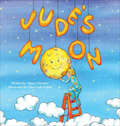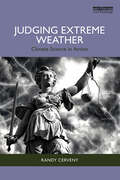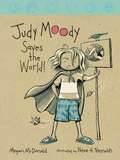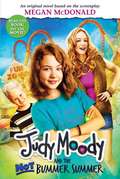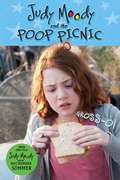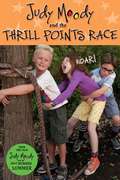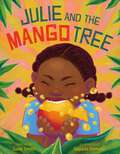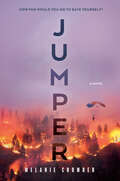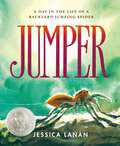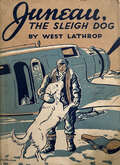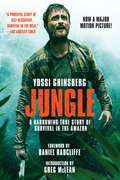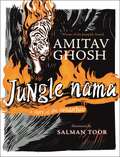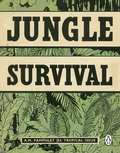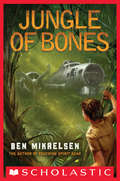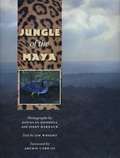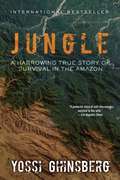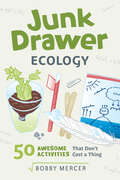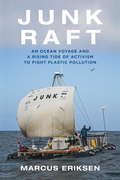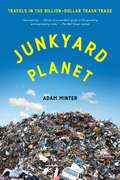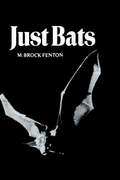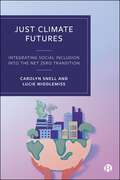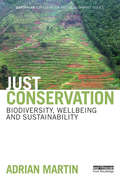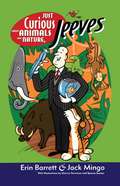- Table View
- List View
Jude's Moon
by Nancy GuettierNighttime is the best time for a boy and his best friend in this charming tale from the author of Circus in the Sky and Mermaids on Mars. Jude’s Moon is a delightful story of a little boy who is fascinated by the moon. He believes he is the only one who can see it, so he is always so excited to point it out to his mom. “There’s the moon!” he shouts with glee every time he sees it. One day Jude is confused when the moon changes shape. He thinks someone has stolen his moon and replaced it with a croissant. When he learns it is a crescent moon, he is even more curious to learn how it changes shapes. This story is a fun and easy way to educate children on the phases of the moon. “I recommend this book to kids that love science, teachers that want to teach their class about moon phases and parents that love to read with their kids.” —5 Girls Book Reviews “In Jude’s Moon, Jude loves the moon so much that he believes he is the one who hung it in the sky. Throughout the story, Jude examines the phases of the moon, as well as fun facts about the sun.” —MySocialGoodNews.com
Judging Extreme Weather: Climate Science in Action
by Randy CervenyWritten by the World Meteorological Organization (WMO) Rapporteur of Weather and Climate Extremes, this book addresses the reality of extreme weather—how it occurs, how we measure it, and what it means for our future. Weather affects everybody, and with the increasing impact of climate change and the prevalence of storms, droughts and floods, it is clear that we are affecting all aspects of weather. Consequently, people love to talk about weather, complain about it, argue about it—and be intrigued by it. Twenty-four/seven coverage of the weather, however, has helped foster a tendency for marked overstatement—the creation of misconceptions, exaggerations and, frankly, even outright lies. Leading expert in weather and climate, Randy Cerveny, draws on his extensive experience with the WMO and personal research to give the reader a behind-the-scenes look at how weather and climate extremes are recorded and defined. He unpacks the science behind these extremes through a number of specific WMO investigations that span a diverse range of countries and weather events, including lightning, rain, hurricanes and tornadoes. Cerveny balances these factual accounts with playful interludes that detail bizarre and intriguing weather-related stories and anecdotes. This compelling book is a must read for all those interested in the science behind extreme weather.
Judy Moody Saves the World! (Judy Moody #3)
by Megan McdonaldThe mercurial Judy returns - and she's in a mood to take on the world! Get ready for the newest installment in the hilarious Judy Moody series. Rare! Judy Moody did not set out to save the world. She set out to win a contest. A Band-Aid contest. It all started with the Crazy-Strip contest - and the dream that she, Judy Moody, might one day see her very own adhesive-bandage design covering the scraped knees of thousands. But when her "Heal the World" motif merits only an honorable mention, Judy Moody realizes it's time to set her sights on something bigger. Class 3T is studying the environment, and Judy is amazed to learn about the destruction of the rain forest, the endangered species (not) in her own backyard, and her own family's crummy recycling habits. Now she's in a mood to whip the planet into shape - or her name isn't Judy Monarch Moody!
Judy Moody and the NOT Bummer Summer
by Megan McdonaldJudy's big plans for the summer seem ruined when two of her best friends go away, and then her parents leave her and Stink with Aunt Opal, but a new "thrill-a-delic" plan has her racing toward fun.
Judy Moody and the NOT Bummer Summer: The Poop Picnic
by Megan McdonaldJudy is desperately trying to earn thrill points, so she plans a trip to the Cemetery Creep n Crawl. Meanwhile, Stink has been collecting all the samples and evidence he can in his efforts to catch Bigfoot. Add in Aunt Opals crazy driving (and bad sense of direction), and somehow they all end up at an abandoned amusement park, eating scat sandwiches. That's got to be worth some thrill points. . . .
Judy Moody and the NOT Bummer Summer: The Thrill Points Race
by Megan Mcdonald Jamie MichalakJudy Moody is psyched for summer - that is until she realizes that two of her three best friends aren't going to be around: Rocky will be teaching lions to jump through hoops at circus camp, and Amy is going to be searching for lost tribes in the rain forests of Borneo. How can Judy's summer ever compare? But she is determined that her summer will NOT be a bummer, that she and Frank Pearl will have the most NOT bummer summer ever - with plenty of thrill points to prove it!
Jugamos en la nieve (¡Arriba la Lectura!, Level D #18)
by Annette Smith Lyz Turner-ClarkKate y mamá pasan un día divertido. Kate le escribe a papá para contarle todo. NIMAC-sourced textbook
Julie and the Eagles (American Girls #4)
by Megan McdonaldJulie and Ivy are eating snow cones in Golden Gate Park when they hear an odd sound. It's a baby owl-and it needs help. At a wildlife rescue center, Julie meets Shasta and Sierra, two bald eagles. Shasta's wing is injured, and Julie hopes he'll be able to fly again-but that can happen only if the rescue center raises enough money to release the eagles back into the wild. Julie feels sure that if people knew about the eagles, they'd want to help. For Earth Day, Julie thinks of a unique way to tell the public of the eagles' plight. But money isn't exactly pouring in ... and time is running out.
Julie and the Mango Tree
by Sadé SmithCoupled with Sayada Ramdial’s bright and colorful artwork, Julie and the Mango Tree by Sadé Smith will have readers of all ages giggling—and craving a mango of their own! <P><P>Julie loves all kinds of fruit, but mangoes are her absolute favorite. One sticky summer afternoon, Julie goes to the big mango tree in her yard to ask for a snack. But no matter how nicely she asks or how patient she tries to be, the tree just won’t drop a single sweet, juicy mango! Will Julie ever be able to convince the tree to let her have just a taste of her favorite treat?
Jumper
by Melanie CrowderIn a ripped-from-the-headlines story, nineteen-year-old Blair's passion for fighting fires lands her a spot with the Forest Service and sets her on a wilderness adventure that quickly turns catastrophic.How far would you go to save yourself? Blair Scott is in her second season as a wildland firefighter when the Forest Service puts out a call for an additional class of smokejumpers. She and her best friend Jason both apply, though neither expects to get in since they&’re only nineteen. But it&’s been a devastating fire season, and they are both accepted. But going to training camp is only the first step—everyone expects the teenage rookies will wash out in the first week. Blair has always been touchy about people telling her she isn&’t good enough, so she begins taking unnecessary risks to prove herself. It doesn&’t take long before everything spins out of control, leaving Blair struggling to cope. A story of courage, self-knowledge, and ultimate triumph over the elements, Jumper is a dramatic wilderness adventure that explores what it takes to survive—in every sense of the word. "Never less than riveting." –Kirkus, starred review "Blair is a fierce and dynamic narrator, and Crowder&’s (Mazie) immersive prose, crisp dialogue, and haunting descriptions of devastating fires enlivens this pulse-pounding thriller." –Publisher's Weekly, starred review
Jumper: A Day in the Life of a Backyard Jumping Spider
by Jessica LananFrom critically acclaimed illustrator of The Lost Package comes a bold nonfiction story following a day in the life of a backyard jumping spider - meticulously researched and utterly charming.What if you were small as a bean,Could walk on the walls and ceiling,Sense vibrations through your elbows,And jump five times your body length?That is Jumper's world.Open this book to discover the vibrant, hidden life of a backyard jumping spider.
Juneau: The Sleigh Dog (Famous Dog Stories)
by West LathropPierre Barnard never dreamed when he left New York City on a northern vacation that he would be separated from his father, deserted by Ka-uk, their Indian guide, and left alone, snowbound in a cabin in the Alaskan wilderness. Alone--except for a huge gray sleigh dog, Juneau--and with a small box to be protected. The mysterious contents of that box proved to be more than a responsibility. Because of them Pierre found that he had to deal with a crafty enemy who forced the boy to use all his resources to outwit him. Starvation threatened, strange footprints encircled the cabin, a cry sounded from the depths of a crevasse--and through these and other experiences Pierre's sole friend and companion was Juneau, an outcast and veteran of the trail, whose unerring wisdom and devotion constantly guided and guarded him. This story of an average American boy, unused to real hardship but possessed of determination and fortitude, and of his struggle to exist in the frozen wastes of Alaska, is a vivid narrative of character put to the test--of the maturity that resulted from Pierre's having met difficult situations with decision and courage. Written with singular beauty and force, each chapter holds the reader in stirring suspense.
Jungle (Movie Tie-In Edition): A Harrowing True Story of Survival in the Amazon
by Yossi Ghinsberg Greg McLeanFour travelers meet in Bolivia and set off into the heart of the Amazon rainforest, but what begins as a dream adventure quickly deteriorates into a dangerous nightmare, and after weeks of wandering in the dense undergrowth, the four backpackers split up into two groups. But when a terrible rafting accident separates him from his partner, Yossi is forced to survive for weeks alone against one of the wildest backdrops on the planet. Stranded without a knife, map, or survival training, he must improvise shelter and forage for wild fruit to survive. As his feet begin to rot during raging storms, as he loses all sense of direction, and as he begins to lose all hope, he wonders whether he will make it out of the jungle alive.The basis of an upcoming motion picture starring Daniel Radcliffe, Jungle is the story of friendship and the teachings of nature, and a terrifying true account that you won’t be able to put down.
Jungle Nama
by Amitav Ghosh'One of the finest writers of his generation' Financial TimesThousands of islands rise from the rivers' rich silts,crowned with forests of mangrove, rising on stilts.This is the Sundarban, where great rivers give birth;to a vast jungle that joins Ocean and Earth.Jungle Nama is a beautifully illustrated verse adaptation of a legend from the Sundarbans, the world's largest mangrove forest. It tells the story of the avaricious rich merchant Dhona, the poor lad Dukhey, and his mother; it is also the story of Dokkhin Rai, a mighty spirit who appears to humans as a tiger, of Bon Bibi, the benign goddess of the forest, and her warrior brother Shah Jongoli. Jungle Nama is the story of an ancient legend with urgent relevance to today's climate crisis. Its themes of limiting greed, and of preserving the balance between the needs of humans and nature have never been more timely.Written in Amitav Ghosh's interpretation of the traditional Bengali verse meter, poyar, the poem is coupled with stunning illustrations from internationally renowned artist, Salman Toor.
Jungle Survival (Air Ministry Survival Guide #2)
by A.M. Pamphlet 224THE ULTIMATE SURVIVAL GUIDE for anyone who thinks they'd survive the world's most hostile environments - or at least imagine they could do.-----------------------------First issued to airmen in the 1950s, the Air Ministry's Sea Survival guide includes original and authentic emergency advice to crew operating over the ocean. With original illustrations and text, these survival guides provide an insight to military survival techniques from a by-gone era.Packed with original line drawings and instruction in:- What to do if 'jungle hiking becomes boring'- How to stay safe from poisonous reptiles and insects- The benefits of using a 'fire thong'Focussing on one of the most hostile environments on Earth, Jungle Survival is one of four reprints of The Air Ministry's emergency survival pamphlets. Others include:Sea SurvivalDesert SurvivalArctic Survival
Jungle of Bones
by Ben MikaelsenLost and alone in the jungle, one boy will have to let go of his assumptions and anger, or be dragged down with them.Dylan Barstow has finally crossed the line. After getting caught on a late-night joyride in a stolen car, Dylan is shipped off to live with his ex-Marine uncle for the summer. But Uncle Todd has bigger plans for Dylan than push-ups and early-morning jogs. Deep in the steamy jungles of Papua New Guinea, there's a WWII fighter plane named SECOND ACE that's been lost for years, a plane that Dylan's own grandfather barely escaped from with his life. In all this time, no one has ever been able to track down SECOND ACE -- but now Dylan and his uncle are going to try.Lush and haunted, vital and deadly, these alien jungles half a world away could mean Dylan's salvation, or they could swallow him whole.
Jungle of the Maya
by Jim Wright Archie Carr IIIThe Selva Maya (Jungle of the Maya) is one of the world's most magical yet least appreciated places--an enormous tropical forest that encompasses much of Belize, Guatemala, and Mexico's Yucatan Peninsula.<P><P> At 9,000,000 acres, it is the largest contiguous tropical forest north of the Amazon in the Western Hemisphere. Within its borders, the Selva Maya provides habitat for an astonishing diversity of plants and animals--more than 500 species of birds alone. The forest also contains the fascinating ruins of ancient Maya cities, which attract visitors and researchers from all over the globe.
Jungle: A Harrowing True Story of Survival in the Amazon
by Yossi Ghinsberg Greg Mclean“A powerful story of self-discovery, survival in the wild. ” —Los Angeles Times Four travelers meet in Bolivia and set off into the heart of the Amazon rainforest, but what begins as a dream adventure quickly deteriorates into a dangerous nightmare, and after weeks of wandering in the dense undergrowth, the four backpackers split up into two groups. But when a terrible rafting accident separates him from his partner, Yossi is forced to survive for weeks alone against one of the wildest backdrops on the planet. Stranded without a knife, map, or survival training, he must improvise shelter and forage for wild fruit to survive. As his feet begin to rot during raging storms, as he loses all sense of direction, and as he begins to lose all hope, he wonders whether he will make it out of the jungle alive. The basis of an upcoming motion picture, Jungle is the story of friendship and the teachings of nature, and a terrifying true account that you won’t be able to put down.
Junk Drawer Ecology: 50 Awesome Experiments That Don't Cost a Thing (Junk Drawer Science #7)
by Bobby MercerKids of all ages can use recycled and repurposed household items to complete exciting and green ecology experimentsJunk Drawer Ecology is a hands-on guide to saving the planet. Fun, free science activities help kids of all ages learn about the science of our planet's ecology. The environment is changing every day, and we can help slow that change. Using free or low-cost things children already have around their homes, these activities are perfect to stimulate young brains. Readers will learn about the importance of the polar regions without leaving their communities, about new ways to cut our dependence on fossil fuels, about all forms of pollution, and how they can make a difference.Junk Drawer Ecology will give inquisitive kids many hours of fun and help them learn at the same time.
Junk Raft: An Ocean Voyage and a Rising Tide of Activism to Fight Plastic Pollution
by Marcus EriksenAn exciting account of an activist scientist’s unorthodox fight in the growing movement against plastic marine pollution and of his expedition across the Pacific on a home-made “junk raft”News media brought the “Great Pacific Garbage Patch”—the famous swirling gyre of plastic pollution in the ocean—into the public consciousness. But when Marcus Eriksen cofounded the 5 Gyres Institute with his wife, Anna Cummins, and set out to study the world’s oceans with hundreds of volunteers, they discovered a “plastic smog” of microscopic debris that permeates our oceans globally, defying simple clean-up efforts. What’s more, these microplastics and their toxic chemistry have seeped into the food chain, threatening marine life and humans alike.Far from being a gloomy treatise on an environmental catastrophe, though, Junk Raft tells the exciting story of Eriksen and his team’s fight to solve the problem of plastic pollution. A scientist, activist, and inveterate adventurer, Eriksen is drawn to the sea by a desire to right an environmental injustice. Against long odds and common sense, he and his co-navigator, Joel Paschal, construct a “junk raft” made of plastic trash and set themselves adrift from Los Angeles to Hawaii, with no motor or support vessel, confronting perilous cyclones, food shortages, and a fast decaying raft.As Eriksen recounts his struggles to keep afloat, he immerses readers in the deep history of the plastic pollution crisis and the movement that has arisen to combat it. The proliferation of cheap plastic products during the twentieth century has left the world awash in trash. Meanwhile, the plastics industry, with its lobbying muscle, fights tooth and nail against any changes that would affect its lucrative status quo, instead defending poorly designed products and deflecting responsibility for the harm they cause.But, as Eriksen shows, the tide is turning in the battle to save the world’s oceans. He recounts the successful efforts that he and many other activists are waging to fight corporate influence and demand that plastics producers be held accountable. Junk Raft provides concrete, actionable solutions and an empowering message: it’s within our power to change the throw-away culture for the sake of our planet.
Junkyard Planet: Travels in the Billion-Dollar Trash Trade
by Adam Minter<p>When you drop your Diet Coke can or yesterday's newspaper in the recycling bin, where does it go? Probably halfway around the world, to people and places that clean up what you don't want and turn it into something you can't wait to buy. In Junkyard Planet, Adam Minter--veteran journalist and son of an American junkyard owner--travels deep into a vast, often hidden, five-hundred-billion-dollar industry that's transforming our economy and environment. <p>With unmatched access to and insight on the waste industry, and the explanatory gifts and an eye for detail worthy of a John McPhee or a William Langewiesche, Minter traces the export of America's junk and the massive profits that China and other rising nations earn from it. What emerges is an engaging, colorful, and sometimes troubling tale of how the way we consume and discard stuff fuels a world that recognizes value where Americans don't. Junkyard Planet reveals that Americans might need to learn a smarter way to take out the trash.</p>
Just Bats
by M. Brock FentonBats are dangerous to man. Right? Wrong. Here is the truth about chiroptera, the only mammals that fly, in a short, well-illustrated account based on solid research but intended for a general reader. Bats, of which there are about 850 species in the world, are maligned as carriers of rabies (largely untrue) and admired for their biosonar. Heir diversity is reflected in their diets: some eat fruit, some nectar and pollen, other fish, birds, frogs, or other bats. Although most eat insects, it is the three species of blood-feeding vampires which receive most public attention and around which much myth and superstition (and misconception) have evolved. In addition to their diet and habit, Fenton discusses their remarkable sonar sight, their reproduction, migration, patterns of behavior ? from hunting to mating ? parasites, enemies, and life span. (The current record is held by an Ontario Little Brown Bat which in 1980 had survived more than 30 years. ) Man?s attitude toward bats, his destruction of their habitats, and his use of pesticides have contributed to a sharp decline in the bat population in many parts of the world. Many biologists are becoming increasingly concerned about the survival of some species, but maintaining their numbers requires a change in people?s attitudes. Just Bats will help. It will also tell the reader how to evict bats from his attic ? provided he knows how they got in.
Just Climate Futures: Integrating Social Inclusion Into the Net Zero Transition
by Lucie Middlemiss Carolyn SnellIf we are to meet ‘Net Zero’ targets, both climate policies and our daily lives require significant change. The transition towards Net Zero will lead to inevitable trade-offs between social, economic and environmental objectives, and this transition could disproportionately impact households already struggling with poverty and precarity. This book takes a deep dive into the ways families and communities are, or could be, impacted by the implementation of climate policy. It demonstrates that participation in Net Zero requires people to be economically, culturally, socially and politically engaged ̶ and provides a practical roadmap to encourage and support a truly just transition.
Just Conservation: Biodiversity, Wellbeing and Sustainability
by Adrian MartinLoss of biodiversity is one of the great environmental challenges facing humanity but unfortunately efforts to reduce the rate of loss have so far failed. At the same time, these efforts have too often resulted in unjust social outcomes in which people living in or near to areas designated for conservation lose access to their territories and resources. In this book the author argues that our approach to biodiversity conservation needs to be more strongly informed by a concern for and understanding of social justice issues. Injustice can be a driver of biodiversity loss and a barrier to efforts at preservation. Conversely, the pursuit of social justice can be a strong motivation to find solutions to environmental problems. The book therefore argues that the pursuit of socially just conservation is not only intrinsically the right thing to do, but will also be instrumental in bringing about greater success. The argument for a more socially just conservation is initially developed conceptually, drawing upon ideas of environmental justice that incorporate concerns for distribution, procedure and recognition. It is then applied to a range of approaches to conservation including benefit sharing arrangements, integrated conservation and development projects and market-based approaches such as sustainable timber certification and payments for ecosystem services schemes. Case studies are drawn from the author's research in Rwanda, Uganda, Tanzania, Laos, Bolivia, China and India.
Just Curious About Animals and Nature, Jeeves
by Barrett MingoHOW MUCH ELECTRICITY CAN YOU GET FROM AN ELECTRIC EEL? WHEN CAN MISTLETOE BE THE KISS OF DEATH? HOW MANY SHEEP DOES IT TAKE TO GET ENOUGH WOOL FOR A SUIT? WHAT DID BOOK WORMS EAT BEFORE THERE WERE BOOKS? The mysteries of the natural world are endless, but your trusty manservant, Jeeves, has the answers to hundreds of nature's most fascinating mysteries. Based upon questions received at the popular Ask Jeeves® website, Just Curious About Animals and Nature, Jeeves is a fun and freewheeling safari of discovery that can tame even the most savage intellectual curiosity. Packed with incredible facts on everything from the size of a giraffe's tongue (yow, two feet!) to just how fast a fly can fly (4.5mph) to whether dogs have belly buttons (yes, they do), this is a book certain to both amuse and amaze. With a little help from everybody's butler, you'll unlock the secret behind the firefly's glow, wonder at the language of hippos, and scratch your head when you learn the truth about poison ivy. Certain to help you develop the kind of brainpower that will impress your friends and frighten your enemies, Just Curious About Animals and Nature, Jeeves is perfect for fans of flora and fauna, or for anyone who wants to know the whats, whens, whys, and hows of nature.
